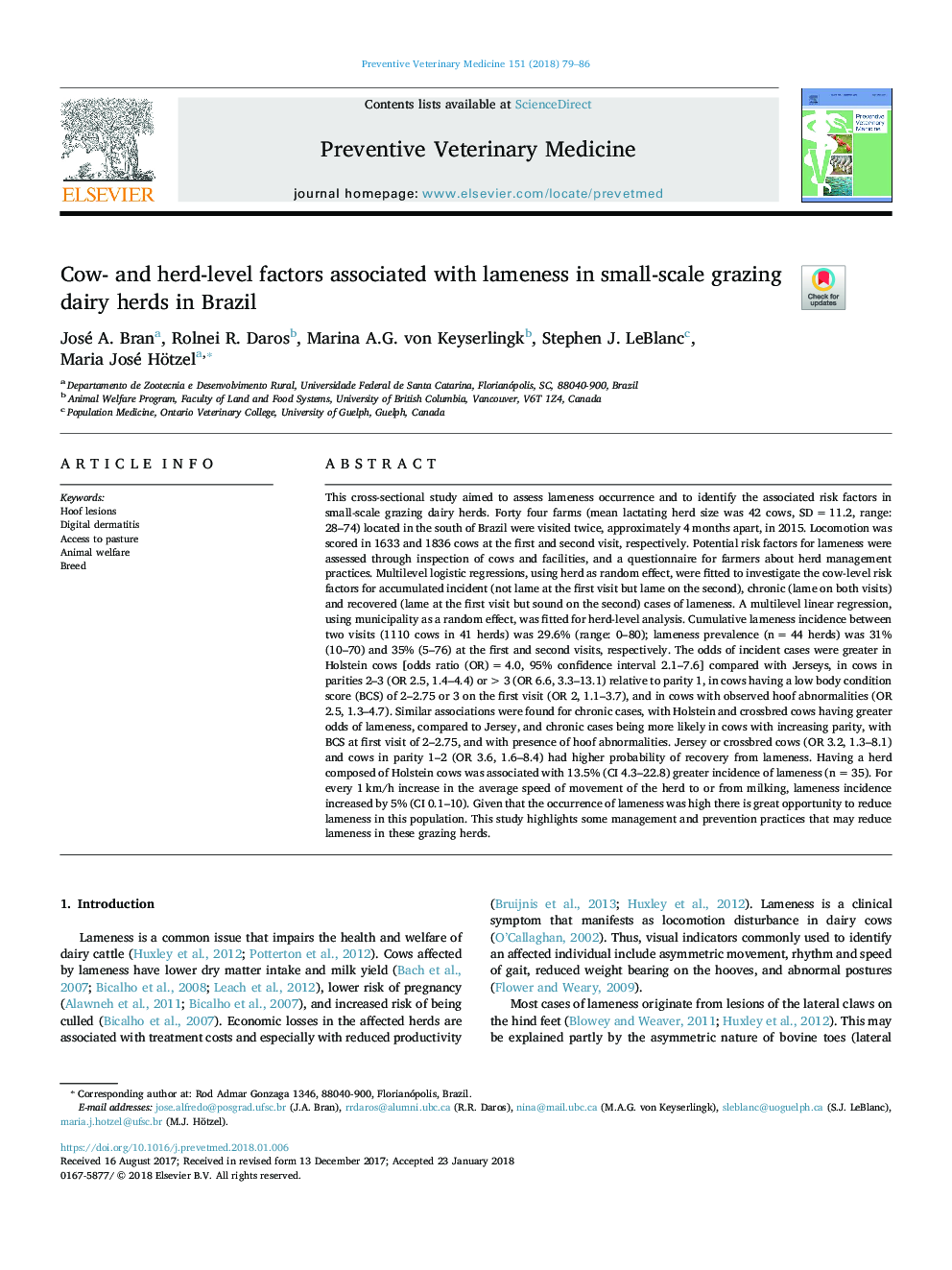| کد مقاله | کد نشریه | سال انتشار | مقاله انگلیسی | نسخه تمام متن |
|---|---|---|---|---|
| 8503535 | 1554139 | 2018 | 8 صفحه PDF | دانلود رایگان |
عنوان انگلیسی مقاله ISI
Cow- and herd-level factors associated with lameness in small-scale grazing dairy herds in Brazil
ترجمه فارسی عنوان
عوامل گاو و گاو در ارتباط با لنگش در گاوهای شیری کوچک در برزیل
دانلود مقاله + سفارش ترجمه
دانلود مقاله ISI انگلیسی
رایگان برای ایرانیان
کلمات کلیدی
ضایعات گوسفند، درماتیت دیجیتال، دسترسی به مرتع، رفاه حیوانات، نژاد،
موضوعات مرتبط
علوم زیستی و بیوفناوری
علوم کشاورزی و بیولوژیک
علوم دامی و جانورشناسی
چکیده انگلیسی
This cross-sectional study aimed to assess lameness occurrence and to identify the associated risk factors in small-scale grazing dairy herds. Forty four farms (mean lactating herd size was 42 cows, SDâ¯=â¯11.2, range: 28-74) located in the south of Brazil were visited twice, approximately 4 months apart, in 2015. Locomotion was scored in 1633 and 1836 cows at the first and second visit, respectively. Potential risk factors for lameness were assessed through inspection of cows and facilities, and a questionnaire for farmers about herd management practices. Multilevel logistic regressions, using herd as random effect, were fitted to investigate the cow-level risk factors for accumulated incident (not lame at the first visit but lame on the second), chronic (lame on both visits) and recovered (lame at the first visit but sound on the second) cases of lameness. A multilevel linear regression, using municipality as a random effect, was fitted for herd-level analysis. Cumulative lameness incidence between two visits (1110 cows in 41 herds) was 29.6% (range: 0-80); lameness prevalence (nâ¯=â¯44 herds) was 31% (10-70) and 35% (5-76) at the first and second visits, respectively. The odds of incident cases were greater in Holstein cows [odds ratio (OR)â¯=â¯4.0, 95% confidence interval 2.1-7.6] compared with Jerseys, in cows in parities 2-3 (OR 2.5, 1.4-4.4) or >3 (OR 6.6, 3.3-13.1) relative to parity 1, in cows having a low body condition score (BCS) of 2-2.75 or 3 on the first visit (OR 2, 1.1-3.7), and in cows with observed hoof abnormalities (OR 2.5, 1.3-4.7). Similar associations were found for chronic cases, with Holstein and crossbred cows having greater odds of lameness, compared to Jersey, and chronic cases being more likely in cows with increasing parity, with BCS at first visit of 2-2.75, and with presence of hoof abnormalities. Jersey or crossbred cows (OR 3.2, 1.3-8.1) and cows in parity 1-2 (OR 3.6, 1.6-8.4) had higher probability of recovery from lameness. Having a herd composed of Holstein cows was associated with 13.5% (CI 4.3-22.8) greater incidence of lameness (nâ¯=â¯35). For every 1â¯km/h increase in the average speed of movement of the herd to or from milking, lameness incidence increased by 5% (CI 0.1-10). Given that the occurrence of lameness was high there is great opportunity to reduce lameness in this population. This study highlights some management and prevention practices that may reduce lameness in these grazing herds.
ناشر
Database: Elsevier - ScienceDirect (ساینس دایرکت)
Journal: Preventive Veterinary Medicine - Volume 151, 1 March 2018, Pages 79-86
Journal: Preventive Veterinary Medicine - Volume 151, 1 March 2018, Pages 79-86
نویسندگان
José A. Bran, Rolnei R. Daros, Marina A.G. von Keyserlingk, Stephen J. LeBlanc, Maria José Hötzel,
